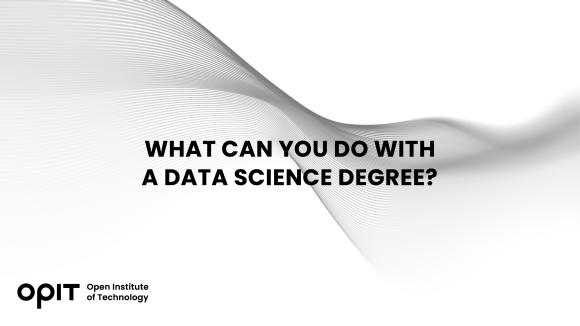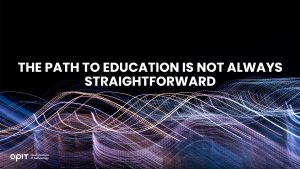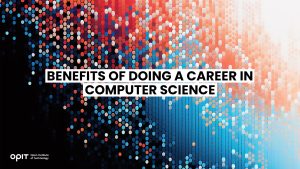

Data is the digital powerhouse, and data science is the driving force behind it. It’s a tool for uncovering stories hidden in data, predicting the future, and making smart decisions that shape industries. So, what can you do with a data science degree? A whole lot, it turns out. Let’s find out more.
Exploring Career Paths with a Data Science Degree:
The demand for data-savvy professionals is skyrocketing across various sectors. Let’s break down the “who’s who” in data science and see where you could fit in.
- As a data scientist, you’re at the forefront of unearthing insights from a mass of data. Day to day, you will build predictive models and algorithms and drive strategic decisions.
- The machine learning engineer role means you develop systems that learn from data and improve themselves without human intervention: smart algorithms that predict user behavior, automate tasks, and even drive cars.
- Data analysts turn data into easily understandable insights. Their toolkit includes statistical analysis, data visualization, and a knack for spotting trends for informed decision-making.
- As a business intelligence analyst, you bridge data and strategy to help organizations make smarter decisions through data. This involves analyzing market trends, monitoring competition, and creating dashboards of the company’s performance.
All this is just scratching the surface. When pondering “what jobs can you get with a data science degree,” there’s nearly limitless potential. With a data science degree, you could work anywhere from tech giants and finance firms to healthcare organizations and government agencies. For just a few examples, you could predict the financial trends and outcomes of a healthcare initiative or follow student progress in an educational institution.
Is a Data Science Degree Worth It?
A data science degree opens pathways to various industries, like online marketing, finances, environment, or entertainment. Clearly, data is everywhere, and so is the demand for those who can understand and manipulate it.
With how widely applicable data science is, salary potential is unsurprisingly vast. It’s a field where six-figure salaries are the norm, not the exception. The median annual wage for data scientist is £59,582 per year in London, and around €78,646 in Berlin. And that’s just the median—many data scientists earn significantly more, especially as they gain experience in high-demand areas.
The demand for data professionals is through the roof. Every company tries to become more data-driven and needs people who can analyze, interpret, and leverage data. This demand translates to job security and plenty of opportunities to advance your career.
Personal growth is another massive perk. Data science is in a permanent flux, which means you’re always learning. New programming languages, machine learning algorithms, or ways to visualize data are being introduced to put you on the cutting edge of tech.
Employment for data scientists might soar by 35% from 2022 to 2032, with an average of 17,700 job openings each year, a much faster growth than the average. Salaries range impressively from $95,000 to $250,000 when expressed in USD.
What to Do With a Data Science Degree Beyond Traditional Paths:
Here are some thought-provoking directions for what to do with a data science degree.
Entrepreneurship
Data science acumen can see you launching startups that use big data. Perhaps you could build apps that predict consumer behavior or platforms that personalize education. Your ability to extract insights from data can identify untapped markets or create entirely new service categories.
Consultancy
As a consultant, you can be the beacon of wisdom for businesses across the spectrum. Your know-how could create a more optimal retail supply chain, mitigate financial risks for a bank, or measure the impact of a nonprofit’s programs.
Positions in Non-Tech Industries
Data science is infiltrating every corner of the economy. You can use data to improve manufacturing, make hospital conditions better for patients, optimize crop yields in agriculture, or contribute to saving the environment by following emission trends. Your skills could lead to breakthroughs in sustainability, quality of life, and more.
Cross-Disciplinary
The intersection of data science with other fields opens up exciting new roles. Consider a career as a digital humanities researcher, where you apply data analysis to uncover trends in literature, art, or history. Or perhaps you could become a legal tech consultant who predicts trial outcomes or analyzes legal documents. Data science collaborating with other disciplines can lead to entirely new fields of study.
Navigating the Intersection: Data Science and Cybersecurity
Data science’s knack for sifting through mountains of data to uncover hidden patterns or predict future threats complements cybersecurity’s focus on protecting these insights and the systems that house them. Therefore, you might have a dual focus: using analytical techniques for data security and applying security principles to protect data integrity. The synergy bolsters defense mechanisms and makes data analysis more sophisticated and broader.
OPIT’s Distinctive Educational Offerings
Studying online makes sense – it’s flexible so you can learn at your own pace, and lets you connect with peers and experts from all over the world. It’s also much more accessible and affordable than traditional education. Starting with the Bachelor’s Degree (BSc) in Modern Computer Science, OPIT gives you a solid foundation to make a mark in data science. This program covers the essentials—programming, software development, databases, and cybersecurity. It’s equally valuable to professionals to boost their skills as well as fresh high school graduates who want a future in computer science.
Furthermore, OPIT’s Master’s Degrees (MSc) in Applied Digital Business and Applied Data Science and AI bring together the business and technology of the future now. These programs reveal the symbiosis between tech and business. Students spearhead digital strategies, manage digital products, and navigate digital finance. In an economy increasingly defined by digital interactions, these degrees prepare you to be at the forefront.
OPIT, as your educational partner, combines career-aligned curricula, flexible studying, creative testing, and the chance to connect to top-dog industry experts.
Data Science Is a Door Opener
Let’s recap the question: “Is a data science degree worth it?” With a data science degree from OPIT, the career paths you take are promising, no matter where you go. If your passion lies in crunching numbers to reveal hidden patterns or using insights to drive business strategies, the qualifications can lead you to numerous possibilities.
Think long and hard about your aspirations and interests, and consider how they align with the power of data science. There will never be a dull moment in your data science career, and OPIT’s program is a surefire way to get you there.
Related posts

Life is unpredictable. While many of us have specific hopes and expectations of how our futures will turn out, things don’t always go as expected. There are many variables and unexpected incidents that can interfere and force you to alter your plans, and this is particularly true when it comes to education.
For instance, you might have had plans to study a specific subject, but had to deviate from those plans due to unforeseen circumstances. Or you may have had to enter the workforce in an occupation different from the one you sought in an effort to earn an income, a move that may not provide you with the time or opportunity to achieve your desired educational aims.
In short, every individual’s career pathway is different, and very few go exactly as we expect from the outset. Fortunately, even if you experience a few false starts or sudden twists in your pathway, there are always options available to help you get back on track.
The Unpredictable Nature of Education
In theory, the educational process seems simple. You select a course of study that interests you from the vast array of subjects and prospective professions, select the appropriate classes, acquire the knowledge and skills you need to succeed, and then embark on your profession.
In reality, however, as many people know from firsthand experience, the road to education is often far from straightforward. Here are just some of the many challenges that can take your educational path in a completely different direction:
- Life’s Curveballs: As touched on in the introduction, life is impossible to predict. Financial hardships, health issues, and family emergencies are just some of the unfortunate occurrences that might derail even the most perfectly planned educational regime.
- Changing Interests: People’s desires and preferences don’t necessarily stay the same throughout their entire lives. As you grow, learn, and have new experiences, your interests may change, and so, too, may your educational objectives.
- Pressure and Burnout: Some academic paths are particularly challenging, demanding intense levels of study and hard work. This can sometimes prove too much to bear, even for the most resilient students.
- Failures and Setbacks: Conventional education largely builds around tests and examinations, requiring students to demonstrate their competencies repeatedly. It’s a system that doesn’t suit everyone, and test failures can lead to setbacks and delays.
- Inequality: People can be born with very different privileges and levels of access to education. Those in certain parts of the world may find it much more challenging to complete their education path for financial, cultural, or even political reasons.
- Late Bloomers: People develop at different paces. Some may struggle educationally early on in their lives, forcing them to make certain concessions or sacrifices related to their studies, only to find their feet later in life once they’ve entered the world of work.
Whether you’re a late bloomer, have had your educational aspirations delayed by personal problems, desire to learn new skills and try something different, or want to begin a fresh chapter in your professional life, the Open Institute of Technology (OPIT) may be able to help.
Introducing OPIT
OPIT is an online teaching platform, making high-level technological educational programs accessible to all, no matter their age or background. Offering education in fields like computer science, artificial intelligence, and digital business, OPIT provides a curated collection of degrees. In addition, they offer classes taught by world-leading tutors imparting the wisdom and skills students need to achieve their goals and become the tech leaders of tomorrow.
Meanwhile, for those who have had somewhat tumultuous or unpredictable educational paths, OPIT offers the perfect course corrector: the OPIT Foundation Year.
The OPIT Foundation Year
OPIT’s Foundation Year is a Pre-Tertiary Certificate in Information Technology, fully aligned with MQF/EQF Level 4 standards and valued at 60 ECTS credits. Lasting just one year, this program essentially serves as a comprehensive yet accessible springboard towards higher-level education, creating a path towards degrees and careers in dynamic, flexible fields, like computer science and digital business.
Like other OPIT programs, the Foundation Year is delivered entirely online via the OPIT Virtual Learning Environment. Combining live lectures, asynchronous content, and interactive assessments, students enjoy diverse and dynamic study experiences, acquiring core skills like academic writing, mathematics, and computer literacy, and building a bedrock of knowledge and confidence before taking their next steps.
Who Is the Foundation Program For?
The Foundation Program is designed to provide a solid base upon which to build the technological education many students need. It’s the perfect choice for those who are eager and ambitious to enter professions in AI, data science, and computing, but don’t feel that they have the necessary core skills and knowledge needed to dive straight into a degree.
Entry requirements are relatively relaxed in order to allow as many students as possible to enjoy the benefits of this program. With that said, applicants should ideally hold an MQF/EQF Level 3 or equivalent qualification, with the intention of pursuing a bachelor’s degree. A minimum of B2 level of English proficiency is also required, as this is the working and studying language of the institution.
What the Foundation Year Provides
Perhaps you’ve recently graduated, are considering a career change, or finally have the opportunity to return to education after initial delays or unexpected disruptions to your original plans. Either way, the Foundation Year can help you enjoy:
- Greater Self-Confidence: Foundation Year graduates gain the fundamental skills they need to enter degree programs with much more self-belief and assuredness.
- Superior Tech Knowledge: Lasting two terms, this course explores mathematics, academic reading and writing, and provides an introduction to computer hardware and software.
- Foundational Mathematics: Mathematics literacy forms a large part of the study focus for the Foundation Year, helping students feel more comfortable with numbers and formulas.
- Flexible Learning: Unlike more rigid, conventional education environments, OPIT gives you the freedom and flexibility to study at a pace that suits you best, all from the comfort of home.
- Global Community: OPIT is an international institution, with staff and students from all around the world eager to share knowledge, exchange ideas, and help one another.
Take Your Next Steps to Success With the OPIT Foundation Year
If you’re curious about a career in technology or have always wanted to work with AI, data, and computers, but struggled to find the time and opportunities you need to acquire relevant skills and knowledge, the Foundation Program was made for people like you.
It’s the ideal entry point into the exciting world of online education, and the perfect first step towards a prestigious degree from an innovative and increasingly successful institution. Download the brochure to learn more about it, or start your online application, today.

Students today have a broader range of fields of study to choose from than ever before, but with the world becoming increasingly technological and computers increasing in influence and importance, pursuing a career in computer science often proves a smart, strategic choice.
There are numerous benefits and career paths associated with studying and working in computer science, and we’ll be listing just a few of them in this guide.
High Average Salaries
With the rising cost of living in many parts of the world, it’s unsurprising that many students are thinking several decades ahead to determine what level of starting salaries they could obtain in different career fields.
Many are also seeking professions that offer the opportunity for growth and the ability to advance up the ranks over time, thus increasing their salary and their quality of life in the process.
If a strong, stable salary with the opportunity for improved income is one of your top career priorities, computer science should be at or near the top of your list of prospective careers.
According to recent data, computer scientists earn an average of over €65,000 per year, with certain jobs, like IT project leader and data scientist, paying ever higher. Starting salaries are strong, too, with graduates earning anywhere from €46,000 to €60,000, depending on their chosen profession and level of qualifications.
There are similarly high average salaries reported around the world in computer science and related fields such as data science and AI/ML engineering. These numbers are projected to increase in the years to come, pointing to computer science as a way for graduates to get off to the best financial start of any career.
Unrivaled Flexibility
A common problem with some subjects and courses is that they only provide graduates with a narrow set of skills and a similarly narrow range of potential professions to which they can apply those skills.
That’s not the case with computer science. Graduates in this field can enjoy instant access to a remarkably diverse array of career opportunities, with even newer opportunities being created all the time as technology evolves and innovations emerge.
A few of the many industries and roles you might choose to enter in the field of computer science include:
- Healthcare: As a software developer, data analyst, or cybersecurity expert
- Finance: As a fintech engineer, blockchain developer, or security analyst
- Media: As a graphics programmer, AI developer, or game developer
- Education: As an analyst, software developer, or machine learning engineer
Guaranteed Opportunities
Some career paths are more limited than others, with relatively low numbers of opportunities, recurring risks of job loss, or difficulty obtaining employment in the first place.
Again, with computer science, this simply isn’t the case. At a time when 75% of companies plan to embrace AI and other technologies by 2027, and businesses of all sizes and industries are now relying on computers more than ever before, computer science graduates can enjoy almost unbeatable job security.
Opportunities will continue to grow for people with good computing knowledge, whether that be in the obvious fields like software and web development, engineering, and AI development, or more niche sectors.
With so many options, you’re effectively guaranteed a long, rewarding career if you put in the necessary time and effort needed to establish a strong foundation of computing skills.
Rapidly Expanding and Evolving Industries
It’s no secret that the world of technology is a dynamic and fast-moving one. In the past 20 years alone, we’ve seen the proliferation of the internet, the rapid advancement of smartphones and wearable devices, the emergence of AI, and so much more.
In the years ahead, engineers and developers will continue to explore the boundaries of modern technology’s powers and potential, driving new innovations and improvements and opening more exciting job opportunities for those already established and experienced in this field.
Getting into computer science now could therefore provide a solid foundation for a career filled with excitement as you uncover and explore new ways of working with computers in fields as diverse as healthcare, finance, education, entertainment, manufacturing, logistics, and beyond.
Start Your Computer Science Career at OPIT
We’ve discussed some of the many benefits associated with careers in computer science, from the high starting salaries to the rapidly growing array of job options available to graduates. By now, you may be eager to follow this particular career path and take advantage of the wealth of opportunities.
If you’re wondering how to start, the Open Institute of Technology (OPIT) may hold the answers you need. As an exclusively online learning platform, specializing in computer science and digital business, and staffed by some of the world’s leading tech experts, OPIT is producing the tech leaders of tomorrow.
Some of the many advantages of learning with OPIT include:
- Accessible and flexible online education that matches your learning style and schedule
- Heavy focus on real-world applications of the skills you acquire
- An international community of like-minded students from around the globe
- A top team of tutors and lecturers from varying fields and industries
- Progressive assessment of skills and understanding – not constant exams
OPIT offers a small, curated selection of courses for those seeking to gain the technological skills and knowledge to succeed in their chosen areas of expertise. That includes a BSc (Hons) in Computer Science – a six-term program, worth 180 ECTS credits.
Numerous IT industry leaders and experts helped develop this fully accredited undergraduate degree, which is online and accessible to all. Like other OPIT courses, it offers a flexible learning program, with progressive assessments, fast-track options, and the opportunity to be part of a growing community of learners and tutors.
If the benefits of doing a career in computer science interest you, download the OPIT BSc in Computer Science brochure or fill out an online application today and take your first step toward a rewarding and fulfilling profession.
Have questions?
Visit our FAQ page or get in touch with us!
Write us at +39 335 576 0263
Get in touch at hello@opit.com
Talk to one of our Study Advisors
We are international
We can speak in:


